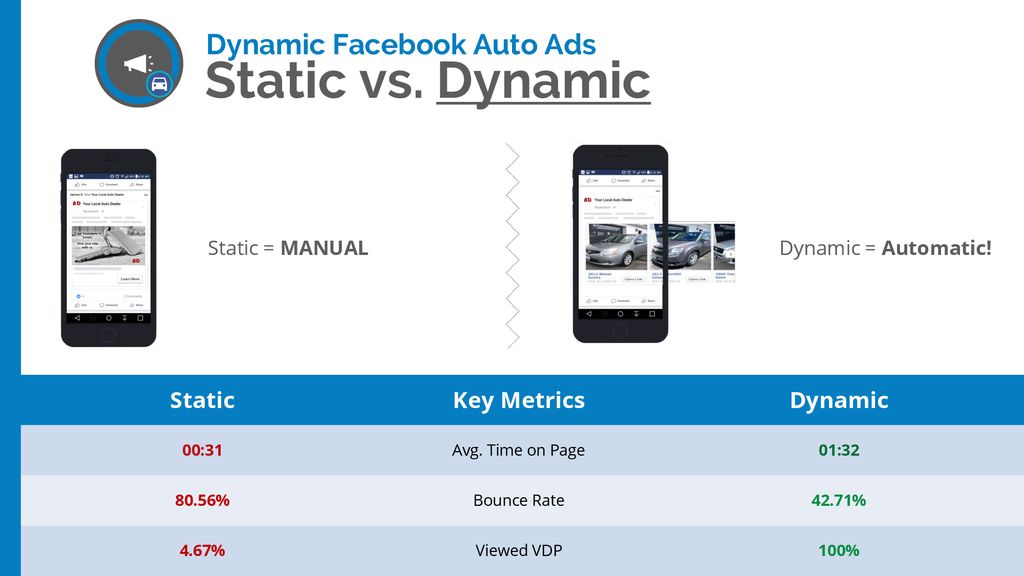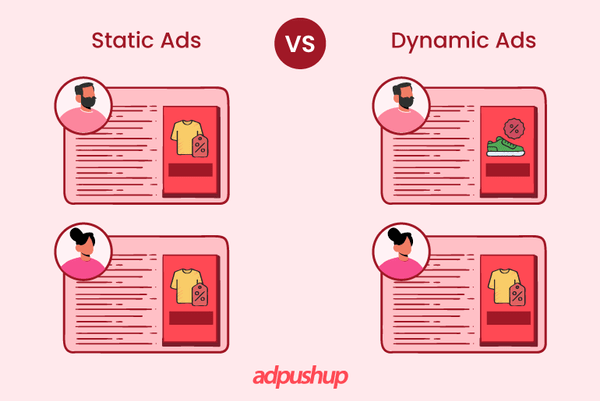Looking to explore the differences, pros, and cons of static vs dynamic ads? Our comprehensive guide covers everything you need to know about static vs dynamic ads. Take a look.
Publishers and marketers strive to reach far and wide audiences or target a specific group of audience via ads strategy and they want to do it effectively.
For that, they pay attention to minute details, various ad formats, and choosing what’s best for the brand. We understand that high-quality ads get more ad impressions, and clicks, and if targeted accurately, they prompt conversions.
One of the most important decisions we require to make is what sort of ads we shall display. Static vs dynamic ads get the most pondering because these ads become the defining factors for client acquisition.
Effective static ads, when displayed accurately, can solve almost any purpose. However, most businesses rely on dynamic ads to target a specific group of audiences and re-target the lead. Let us read further to know more about static vs dynamic ads.
Also Read – What is Ad Format? Different Types, What Users Prefer, & More
Static vs Dynamic: What You Need to Know
In general, the term “static” refers to something that is stationary or unchanging, while “dynamic” refers to something that is energetic and forceful.
However, in the context of computer terminology, the meanings of these static and dynamic are slightly different. In this context, “static” refers to something that is fixed and cannot be changed, while “dynamic” refers to something that is capable of action or change.

What are Static Ads?
Static ads are often misunderstood as dynamic ads; video ads or banner ads with moving text and images. However, static ads are still static, video or still.
Static ads are the best way for publishers to create awareness about their brand among a large audience.
These ads are not focused on any specific group of people. The best part about these ads is that static ads don’t require a lot of creativity and can be supported by almost all advertising networks.
Pros
- Universality:
Static ads reign supreme in universality. Their simplicity translates to easier creation and faster implementation, making them perfect for businesses of all sizes and across industries. They’re cost-effective due to lower technical barriers and potentially lower costs, all while offering design flexibility to craft creative messages that grab user attention. - Easy Adaptability:
Most ad networks accept static ads for their hassle-free display on both desktop and mobile screens. Any type of business within any industry can make use of static ads effectively.
- Highly Convenient:
Static ads are convenient because they don’t require technical or creative expertise or a lot of time to create. It also doesn’t require any maintenance or regular updation because these ads are merely there to tell people about your brand.
- Easily Controlled:
You can easily control and manage static ads because of little to no maintenance and change required. Their content doesn’t need to be changed on a regular basis so static ads are easily controlled and managed.
- Best for Small-Scale Publishers:
Static ads are perfect for publishers who have a fixed or static purpose of showing the ad that involves no regular updation or any change in the ad format, content, or retargeting of the audience.
Cons
- The first and foremost drawback of a static ad is that it is only there to reach a wide audience and basically not target them and prompt them into converting. It lacks interaction because users cannot respond to an ad that is fixed on the site/ app.
- Static ads also lack creativity because they don’t need any. It limits any scope for personalisation or customisation as per the user’s interests.
How to use static ads?
Mostly appearing in the form of animation, image, video, text, or banner ads, static ads, if done accurately, can bring in a lot of people to your landing page or app. Static ads are most suitable for generic offers like- Festival Discounts or Gifts. One can use static ads as:
- Social Media Profiles
- eBooks
- Banners or PPC ads
- Landing pages on a website
- One-way webinars
Also Read – Innovative Ad Formats Guide – AdPushup
How to get the most out of Static Ads?
Now that we have talked enough about static vs dynamic pros and cons of statics ads, let’s understand how you can make the most out of them.
Let’s start with the static ads first.
Static ads are undoubtedly less obtrusive compared to many other ad formats. On top of that, it comes with a classic design, making the design process fun and interesting. But that’s not all that it takes to succeed with static ads.
There are certain tactics you need to keep in mind to get the maximum out of static ads. Have look.
Keep the Message General
Since it can be difficult to show users every nitty-gritty offerings of your brand’s offerings, it’d be a wise idea to keep these ads general.
- Include imagery that effectively demonstrates your business offerings.
- Focus on high-level value props.
- Include USPs.
- Try to make a copy, which can be resonated with any type of audience.
Although statistic ads don’t require much brainstorming over the ad creatives, try to keep them as encouraging as possible. Static ads work best when they are able to set certain expectations.
Brand Awareness
It goes without saying that relevancy can be difficult to achieve since static ads are meant for a wider audience. Therefore, your static ad strategy should involve targeting the people that are yet to be introduced to the people.
Pay Attention to Typography
Unlike dynamic ads, static ads are simple, which is why keeping up with the readability can be quite challenging. Fonts play a vital role in terms of readability. Out of all those options available, going with the sans serif font type and sizing them properly according to the available space is important.
To make your message more clear, avoid trying out different styles and designs like drop shadows, text shading, etc. Instead, you can opt for the black n white letters, which are most preferred in the ads.
Offer Something to the Users
Offering something to the users can work wonders when it comes to increasing the number of clicks. When you have incentives to offer, it encourages the users to engage with your ad. These offers could include a coupon code, a chance to enter a contest, and much more.
Examples of static ads
Banner Ads:
These are the rectangular or skyscraper ads found on webpages, often containing a catchy image, headline, and a CTA like “Shop Now” or “Learn More.” Think of an ad for a new clothing line showcasing trendy outfits with a “Shop Now” button.
Social Media Ads:
Many social media platforms like Facebook and Instagram are filled with static image or video ads. These can promote products, events, or even social causes. Imagine an ad for a local restaurant featuring a mouthwatering dish and the restaurant’s address.
Interstitial Ads:
These are full-page ads that appear between webpage content or during app transitions. They can be static images or short videos designed to grab user attention. For example, an interstitial ad promoting a new mobile game might display exciting gameplay visuals and a “Download Now” button.
Native Ads:
While these are designed to blend with surrounding content, they often function as static ads. Imagine an article about travel recommendations with a sponsored ad showcasing a beautiful beach destination and a link to a booking website.
Print Ads:
Although the digital world dominates advertising, static ads are still prevalent in print media like magazines and newspapers. These can be full-page spreads showcasing a new car model or smaller ads promoting local businesses.
What are Dynamic Ads?
We call these ads dynamic because their content varies depending on user behaviour and other available data. Dynamic ads are created with the sole purpose of targeting a specific set of audiences and delivering a relevant message. These ads are responsive and require changes as per the viewer’s demand.
In other words, dynamic ads are here to retarget a lead to prompt them to convert.
Pros
- Interactive and Personalised:
Dynamic ads vary depending on user behaviour. The changes are based on data related to users’ interests, demands, the next step after seeing the ad, etc. The basic elements in dynamic ads are products, different styles, prices, and/or discounts.
- Brand Loyalty:
These ads bring in brand loyalty as the user gets to see relevant messages or content on these ads. For example, if your shopping cart has an item and you haven’t yet purchased it, the brand will show you ads related to discounts on the same item to prompt you to complete the purchase. The user is most likely to visit you again.
- Higher Visibility:
Not only the users but the search engines too appreciate and positively respond to the dynamic ads. Users share/ subscribe to the content of these ads which in turn reaches far and wide. Hence, higher visibility of these ads.
Cons
- Highly Expensive:
Dynamic ads are expensive to bring in relevant ad units and make changes regularly as per the users’ tastes and demands.
- Demands Efforts:
Dynamic ads need technical, creative, and innovative expertise and regular changes in the content. It also requires exceptional time and effort to always bring in relevant content to the users.
How to get the most out of Dynamic Ads?
Since dynamic ads have much more to offer than dynamic ads, they take more time to be created. These types of ads are capable to handle many types of complex functionalities. Let’s take a look at a few practices to help you make the most out of it.
Audience Segmentation
Unlike static ads, which are less customizable, dynamic ads allow you to target different audience groups. You can segment the audience into different groups based on demographics, interests, and behaviours. This will enable you to create more personalized dynamic ads that resonate with each segment.
Test Different Variations
Dynamic ads allow you to advertise different ad creatives. This experimentation can help find the most relevant ad for your user. You can experiment with different ad assets like ad copy, images, ad format, etc, and determine which combinations deliver the best results.
Scalable Personalization
Another practice for dynamic ads is to leverage their scalability to create and serve a large number of personalized ads to a wide audience. This can help to increase brand reach and awareness while driving more targeted traffic to your website.
To implement this practice, businesses should use data to create personalized ad content based on factors such as location, interests, behaviour, and demographics. They should also use automation tools and dynamic creative optimization (DCO) to create and serve these ads at scale while monitoring their performance to make adjustments as needed.
Examples of dynamic ads
Product Retargeting Ads:
Imagine you browse an online shoe store and check out a pair of sneakers but don’t make a purchase. Later, while browsing a different website, you see an ad featuring those same sneakers from the shoe store you visited earlier. This is a retargeting ad, dynamically displaying products you’ve shown interest in.
Dynamic Search Ads (DSAs):
Let’s say you have an e-commerce website selling a wide variety of sports equipment. With DSAs, you provide the ad platform with information about your website’s content (products, categories). The platform then automatically generates ads based on user search queries. So, if someone searches for “best baseball bats,” your DSA might showcase your top-selling baseball bats within the ad.
Dynamic Display Ads (DDAs):
These ads can tailor their content based on user demographics (age, location) and browsing behavior. For instance, an airline might use DDAs to display ads for weekend getaways to users who have recently searched for travel information.
Social Media Dynamic Product Ads:
Many social media platforms allow you to create dynamic product ads that showcase different products from your catalog based on user profiles and interests. This can be a powerful tool for e-commerce businesses to promote relevant products to their target audience.
Weather-Triggered Ads:
Imagine a scenario where an ice cream brand uses dynamic ads to display refreshing ice cream treats during hot summer days on weather apps or websites. Dynamic ads can leverage real-time data to tailor messaging and product offerings for maximum impact.
Also Read – 6 Types of Ad Tests for Publishers and How to Run Them
Static vs Dynamic Ads: How to Choose?
| Static Ads | Dynamic Ads | |
| 1. | Don’t change; remain static. | Need changes as per the user’s tastes |
| 2. | Easily controlled and managed. | Higher Visibility and promotes brand loyalty |
| 3. | Limited interaction | Highly personalized; directly depends upon the user’s interests. |
| 4. | Mostly to create brand awareness | Mostly used for retargeting |
| 5. | Comparatively fewer conversion rates but high impressions. | Prompts conversions |
| 6. | Most suitable for generic offers like festival discounts | Suitable for specific ad campaigns |
There’s no right/ wrong or one-word answer to choosing- static vs dynamic ads. Small-scale publishers may find it most convenient and easy to go for static ads whereas publishers offering a variety of services or goods can opt for dynamic ads.
It depends upon the nature and the scale of your business. However, the above table showing static vs dynamic ads can lead you in the right direction.
Static + Dynamic Ads: Better Together
Static ads, like banner ads or social media posts, offer broad reach and brand storytelling through eye-catching visuals. Dynamic ads, on the other hand, leverage data to personalize the user experience, showcasing products most relevant to the individual.
Despite their differences, static and dynamic ads can be a powerful duo.
Static ads act as the initial hook, grabbing attention and introducing your brand to a wide audience. Dynamic ads then take over, retargeting users who’ve shown interest and presenting them with personalized offers based on their browsing behavior. This seamless user journey, from brand awareness to conversion, is the magic behind this winning combination.
By strategically incorporating both static and dynamic ads, you can create a well-rounded advertising campaign. Static ads build brand recognition, while dynamic ads leverage data to personalize the experience and drive conversions. So, embrace the strengths of both these advertising approaches to craft a powerful strategy that resonates with your target audience.
To Summarise
Static vs dynamic ads- it is an important choice to make as it directly impacts the business. What type of ads you are displaying on your site or app affects the leads converting. It means, that it’s the business’s needs, nature, and demands that help a publisher go for a certain ad format.
FAQs on Static vs Dynamic ads:
Static banner ads are ads that change over time and are there to create brand awareness amongst a vast audience. Dynamic banner ads are ads that change as per the user’s behaviour. These include content on products, prices, and discounts. Static ads are usually suitable for generic offers while dynamic ads are suitable for specific ad campaigns.
A feature within Google AdWords, dynamic display ads are the ads shown dynamically to users depending upon the products they have browsed or the content they consume on the websites
Static banner ads are ads with content that doesn’t need to be changed over time. Once assembled, these ads are easily maintained and controlled, and with relatively low time and effort commitment.



![Top 12 Ad Networks in India Every Publisher Should Know [2024 Edition] Indian Ad Networks](https://www.adpushup.com/blog/wp-content/uploads/2019/09/undraw_Note_list_re_r4u9-270x180.png)



